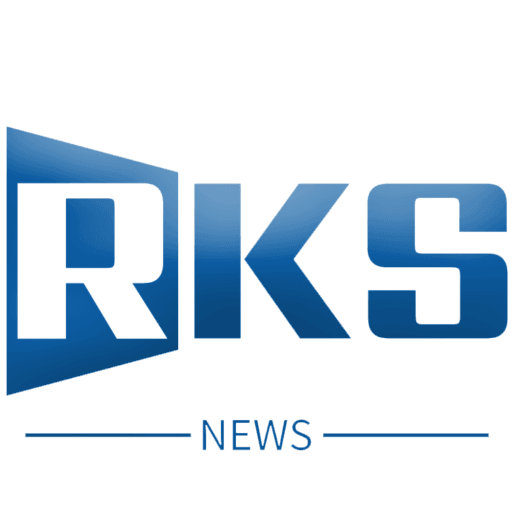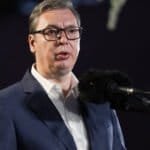Before the Kosovo police start patrolling the border with Serbia, they load the car with weapons: AK-47s are strapped to the back of the car seats, pistols under the legs and drones, and bulletproof vests stuffed in the trunk of Land Rover.
This is now standard protocol at one of the most volatile borders on the European continent.
When people ask Venton Elshan, the deputy police commander in the north of Kosovo, how the situation is, he simply tells them the preparations he makes before patrolling.
“See the guns?” he said, before leading the Telegraph’s film crew to the border, “these are to keep the policemen. The situation is not good.
“Since Kosovo gained independence from Yugoslavia in a war that ended in 1999, it has hosted a small community of ethnic Serbs in the northern border region. Tensions with the ethnic Albanian majority have increased recently. Aleksandar Vučić, the president of Serbia, has hinted at an invasion. The nationalists ask him to act to “protect” the Serbs forced to live under Kosovar “rule”.
Fears of a new war grew in 2023 when an armed group of Serbs stormed across the border into the northern village of Banjska and barricaded themselves in his monastery. Three of the 30 suspected militants were killed in a shootout. One of Commander Elshan’s men lost his life in the exchange of fire.
Since that day, the officer and his team have carried out daily patrols in the Serb-dominated border region, looking for illegal routes into Serbia of the type used by the gunmen in their attack.
“We know these roads better than anyone,” Commander Elshani told The Telegraph as the patrol made its way through the mountains.
“Serbs cannot go any way that we will not find.
“At last count, police identified 65 illegal roads, all blocked with large channels cut into the concrete. Another 10 roads are kept under constant surveillance, mainly through drones. The continuous presence in the region with a Serbian majority sent a message to Belgrade that Kosovo was protecting its borders,” said Commander Elshani.
“Banjska changed the game, put the game on another level because of the deaths,” he said.
“When blood is shed, then it’s a problem.”
Analysts warn that Kremlin propaganda is fueling unrest in the north in a nation where 93 percent are Albanians and 4 percent are Serbs. Most Serbs in Kosovo still regard Belgrade, which has never recognized Kosovo’s independence, as their government.
After the siege, authorities discovered a large cache of weapons that the attackers had hidden in unused buildings around the northern countryside. Just a few weeks ago they discovered five more rocket launchers, a sign of the scale of the planned attack.
In an interview with The Telegraph, Albin Kurti, the prime minister of Kosovo, warned that Mr. Vučić, the president of Serbia, was planning to invade. He said Serbia had built forward operating bases around the border in a “horseshoe shape” to “protect Belgrade and attack Kosovo”.
Distraction from the war in Ukraine
Based on President Vučić’s own words, Kurti believes that the Serbian president is biding his time for an opportunity to conquer.
Vucic’s friendship with Vladimir Putin is well-known, and Kurti believes that it is in the Russian leader’s interest for Serbia to occupy Kosovo, as this would divert attention from his war in Ukraine.
Behind the Mitrovica Bridge that rises over the Iber River, the red, white and blue flag of Serbia flutters everywhere. This bridge was once a “hot spot” – an informal divide between Kosovo’s northern border region and the ethnic Albanian south.
Things seem peaceful as pedestrians walk freely between the two sides.
But there is tension beneath this panorama. Some ethnic Serbs from the north see anyone who crosses south as a traitor, someone who betrays the unhealed wounds of the bloodshed of the 1990s.
Cars are still not allowed to cross the bridge, hampered by the blockade and the 24/7 presence of two policemen in Land Rovers, one parked facing south and the other north.
Police said these precautions were essential to maintain stability in the area.
Rumor has it that Putin has recruited Serbs to fight in his army against Ukraine, and as The Telegraph traveled north, solidarity with Russia was omnipresent.
The letter “Z” was graffitied on the sides of local shops, cafes and houses.
Albin Kurti says: “This is the pool from which they [Russia] will recruit future Wagner paramilitaries for Ukraine and the Balkans.”
On a road sign, someone had written the words “F— k Nato”, a warning about the peacekeeping presence of the KFOR bloc, which has been stationed in Kosovo since 1999.
Like the police, they conduct patrols, keeping an eye on what they call the administrative border line, a 237-mile stretch of land that separates Kosovo and Serbia.
1st Lt. Caldëll of the Georgia National Guard, who makes up America’s contribution to KFOR, said their job was to detect anyone intent on pursuing hostile activity.
He emphasized the importance of “interrupting” illegal routes to stop the passage of smugglers into Kosovo. According to him, more road closures were being carried out whenever possible.
For Commander Elshanin, his men are training for an attack.
“It’s no surprise that Vucic wants to conquer,” he said.
“They can shoot us, but they can’t scare us. /rtsh







